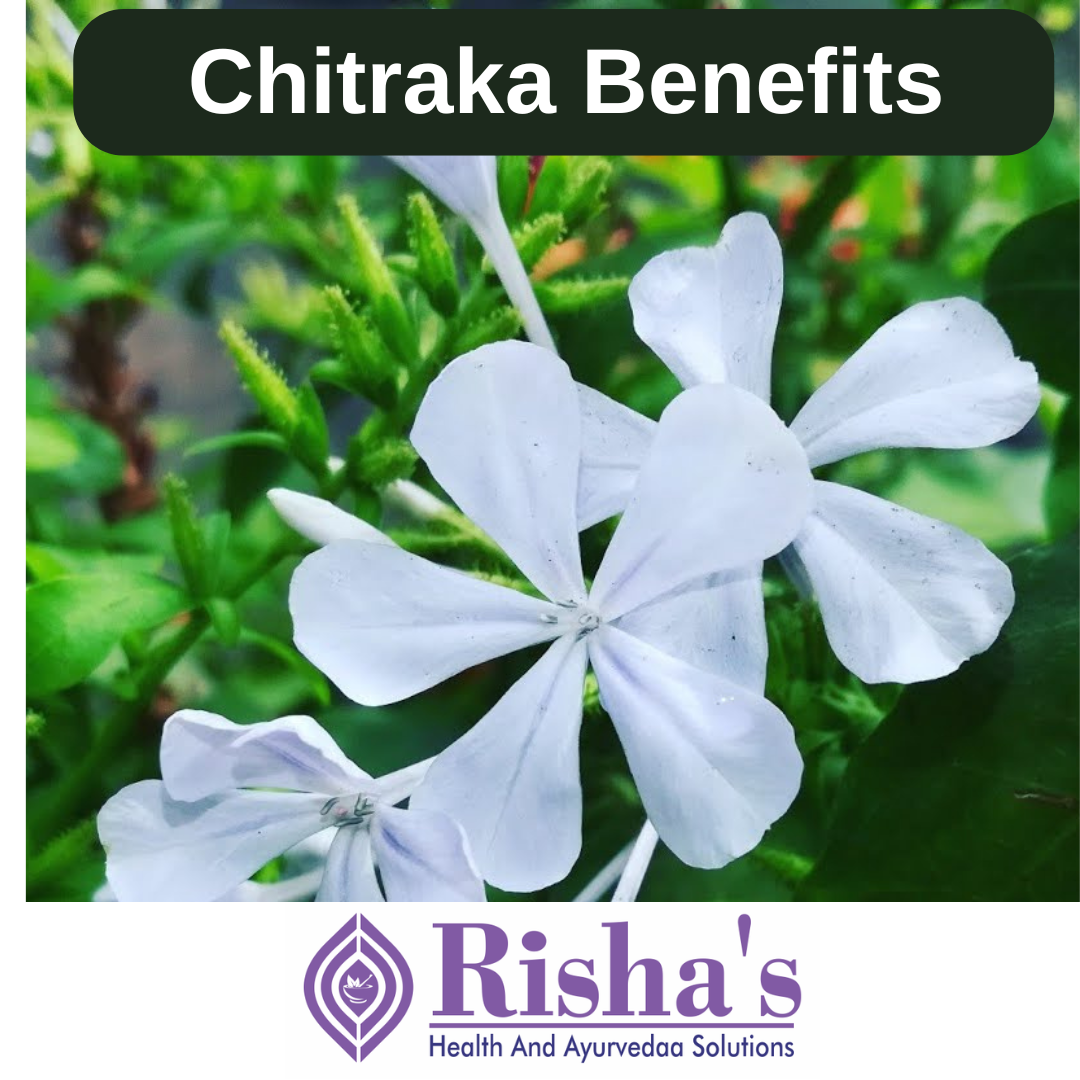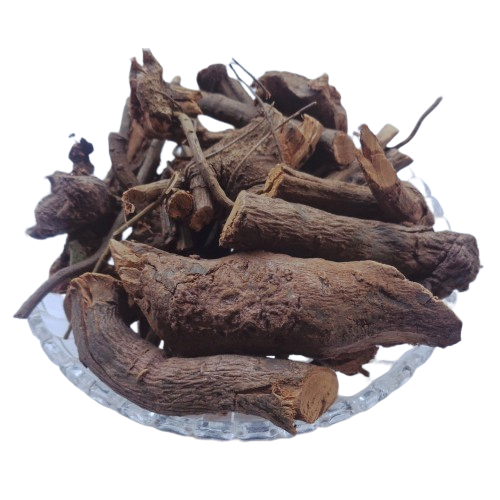Chitrak benefits,uses and home remedies

What are the benefits of chitrak
Chitrak is well known for its benefits in healing common digestive and metabolic problems. It is one of the few herbs that command much respect in Ayurveda medicine. This herb is commonly referred to as the leadwort or Ceylon leadwort. The name chitrak translates to spotted one in sanskrit, possibly alluding to its striking flowers or its distinctive healing energy.
Latin Name: Plumbago Zeylanica
Vernacular Names:
- Hindi: Cheeta, Chitra
- Bengali: Chita, Chitu
- Tamil: Chittiri , Chittira, Kodivel
- Telugu: Chitramulamu , Agnimatha
- Kannada: Chitramula, Bilichitramula
- Malayalam: Vellakotuveri, Kotubeli
- Marathi: Chitramul, Chitrak
- Gujarati: Chitro, Chitra, Pitaro
- Punjabi: Chitra
- English : Leadwort
Sanskrit Names:
Agnika : Having qualities of fire.
Jarana : Helps in digesting food.
Analanama : It has burning qualities like that of Agni.
The other sanskrit names are Anala , Dahana , Pithi, Vahnisajnaka , Agni, Jyothi, Nirdahana, Vahni, Sikhi .
Chitrak benefits & Ayurvedic Description
Chitrak is a hardy, perennial, semi-woody shrub that can grow up to 1–2 meters (3–6 feet) tall. It has a spreading or scrambling growth habit. The stems are slender, branched, and green or slightly reddish when young. As it matures, the stem becomes woody at the base.
Leaves: are ovate to oblong in shape and are arranged alternately. The surface is smooth , with pointed tip and entire margin. Leaves are used to make vegetables.
Flowers are white or pale pink or bluish in color. The flowers blooms in warm season.
The root is the most medicinally valuable part. It is thick, cylindrical, and reddish-brown on the outside, with a strong, pungent odor and acrid taste. In Ayurveda, this root is used after purification (Shodhana) due to its intense potency.
Chitrak Medicinal properties
Chitrak, also known as Plumbago zeylanica, is a perennial medicinal shrub widely recognized in Ayurveda for its therapeutic benefits. Native to Southeast Asia, it is commonly found growing in tropical and subtropical regions, including India.
Ras ( Taste)
- Katu (Pungent)
Veerya ( Potency)
- Ushna (Hot)
Vipaak ( Post-digestive effect)
- Katu (Pungent)
Guna ( Qualities)
- Laghu (Lightness)
- Rooksha (Dry)
- Teekshan ( Piercing)
Classical Categorization
Acharya charak has classified chitrak into following group .
1. Deepaneeya : This is group of herbs that help improve digestion and appetite.
2. Shoolprashamana : Group of herbs that relieve abdominal pain and colic pain.
3. Arshoghana : Group of herbs used in treating piles.
4. Lekhaneeya : Group of herbs having scrapping property.
Achayra sushrut has classified it into
Pippalyadi, Mustadi, Amalkyadi, Varunadi, Aragvadadi group of herbs.
Vagabhata :
Pippalyadi, Mustadi, Varunadi, Aragvadadi group of herbs.
Bhavprakash Nighantu : Haritakyadi varga
Raj Nighnatu : Pippalyadi Varga
Purification process of chitraka (Shodhana)
The purification of chitraka is done by following way
- Take roots of plumbago zeylenica and cut into pieces. Then immerse this root in lime juice for 3 hours. It is then taken out and then again immersed in fresh lime water for another 3 hours. The process is repeated for 3 times.

Benefits of Chitrak mool churna
Boost digestive system
Chitrak has immense benefits in digestive problems. It helps in improving gut health and treating a wide range of gastrointestinal disorders like diarrhoea, flatulence, peptic ulcer, esophagitis, heartburn, gastroesophageal reflux disease, indigestion, and stomach pain. It has got deepan ( digestive) and pachan( carminative) properties which helps to break down the food particles in the stomach and intestine, improves the secretion of the digestive juices and thereby boosts the absorption of essential nutrients through the intestines.
Combat respiratory problems
Chitrak benefits in respiratory problems because of it’s Kapha pacifying and lekhaniya ( scraping) quality. As a result of this ,it helps to thins and loosens up the phlegm(bulgem) deposits within the chest and nasal cavities and hence facilitates smooth breathing. It is also highly effective in attending to bronchitis and asthmatic conditions.
Relieves piles
In Ayurveda piles is considered as disease of digestive system. The deepan ( digestive ) and pachan ( carminative) quality of chitrak helps in improving digestion. Because of this it helps in relieving the constipation which is the main cause of piles. . The potent Rechana (laxative) property of Chitrak softens the stools and facilitates effortless passage of the stool from the intestines and the anus. This helps in easing the presure of anus thus relieving piles.
Aids in weightloss
The root cause of weight gain is mandagni means weak digestion power. Because of weak digestive fire the food is not properly digested and toxins start accumulating . This leads weight gain and high cholesterol in blood. Chitrak is having digestive and carminative properties and help in improving metabolism and help in shedding excess weight faster.
Helps manage diabetes
The Chitrak root powder contains a potent, naphthoquinone compound called Plumbagin which not only imparts the pungent taste to the root but also plays a crucial role in assuaging the blood sugar levels of the body. Production of insulin from the β-pancreatic cells becomes active in the consumption of the root powder of Chitrak. Adequate dosage of this herb also helps to reduce the breakdown of starch into glucose and hence manage.
Advantages of Chitrak in Ayurveda
Vahnikrut : Improves digestion strength
Pachana: Useful herb that aids digestion.
Laghu: Light to digest
Grahnihar: helps to relieve digestive probelms like IBS.
Shothara: Useful in relieving inflammation.
Kushta : Useful in skin problems.
For Vata dosha it must be administered with sesame oil.
For Kapha dosha it must be administered with honey.
Chitraka balanaces Vata-Kapha dosha .
Chemical composition
Chitrak intrinsically possesses a vast array of chemical components including chitramone, B- chloroplumbagin, droserone, elliptinone, zeylanone and zelynone. Also it possesses flavonoids, alkaloids, glycosides, steroids, triterpenoids, saponins, tannins, coumarins, phenolic compounds, naphthoquinones, carbohydrates, fixed oil and fats and proteins. Among them, the most important chemical constituent is Plumbagin which is chiefly present in the roots of Chitrak and bestows the plant with incredible curative qualities.
How to use Chitrak
Chitrak mool (root) can be consumed in various forms, including:
- Chitrak mool churna: This form can be taken directly by making powder from the roots of chitrak. 1/2 to 1 teaspoon of this powder with water two times after meals.
- Chitrak tablet: 1 to 2 tablets two times a day after meals.
- Part Used : Root Bark.
What are the side effects of Chitrak
Like most of the ayurvedic herbs chitrak is also having many benefits, however if not taken in proper quantity then it may lead to certain side effects like
- Heartburn
- Abdonimal pain
- Redness and itching of skin
- Muscle contarction
- Increased pulse rate
Precautions
During breast feeding avoid consuming chitrak.
Avoid consuming Chitrak during pregnancy due to lack of research on safety during pregnancy.
Always use chitrak in recommended dosage to avoid potential side effects such as nausea and bloating. It is better to ask Ayurveda doctor about dose and suitability for your body type.
If you have pre existing medical conditions or taking any medications, consult a doctor before using chitrak. This ensures that there are no harmful interactions or contraindications.
Don’t use chitrak continuosly for long period of time . Take break to allow your body to respond appropriately. Also when we use any herb continuosly ,then the body becomes use to it and it don’t respond to it.
Store chitrak mool powder in cool and dark place to maintain its potency and prevent it from contamination. Proper storage helps in retaining its therapeutic value.
Home Remedies of chitrak
For relief for itching and eczema : Take bark of chitrak mool and make powder and add this to white butter in one plate. Now keep this plate in slanting position. Now you will find ghee ( clarified butter) on other side of plate. Applying this ghee on parts affected by itching helps cure itching.
In digestive problems: Take chitrakmool powder and deodar powder in equal quantity and mix them. Consume this mix 2 gms daily with milk help to improve digestion.
To Relieve Piles : Take chitrak churna add little water to it and make a paste. Now apply this paste on the inner surface of a earthen pot, then add buttermilk into this pot. Keep it overnight . Collect the buttermilk in new glass. Drink this buttermilk help to cure piles. Do it for 21 days.
In liver and Spleen enlargement: Consuming kshar made from chitrak helps in both this conditions.
Frequently asked question
1.Can this herb be used while taking homeopathic medicine ?
Yes. This herb does not react with homeopathic medicine.
2.Can this herb/medicine be continued while taking supplements like multivitamin, omega 3, spirulina ?
Yes .Generally this herb goes well with most dietary supplement. However if you are taking more than one product per day please consult your doctor for opinion.
3. With western/modern medicine
Seek your doctors advice if you are taking this product along with other western (allopathic/modern) medicine. Some ayurvedic herbs can interact with modern medicine.
When taking ayurvedic medicine or herb with modern medicine it is best to keep one hour gap in between both the medicine.
4. How long does chitrak take to start showing benefits ?
It depend on any existing disease, overall health, your prakriti ( genetic make up) all these factors plays a role in how quickly chitrak powder benefits are seen.
5.Can it be used in people with diabetes?
Yes. But always keep watch on your sugar levels. This herb can lower your blood sugar levels. Do not stop your diabetes medicine once you start taking this herb/medicine. Keep in touch with your ayurvedic doctor. They will guide you in this respect.
6.Are there any diet restriction( Pathya) while taking this seeds ?
No .There are no such restriction while taking this product. However if you have been advised with any specific diet based on disease, you should continue to follow it.
Ayurvedic medicine that contains Bhringraj
Chitrak is the main ingredients in following medicines
Chitrakadi vati: It is one of the ayurvedic medicine which is used to treat digestive problems and constipation.
Chitrak haritaki: It is used in respiratory problems like allergic rhinitis, cold and cough, asthma and others
Conclusion
The Chitrak plant (Plumbago zeylanica) stands out as a powerful medicinal herb with deep roots in traditional Ayurvedic practices. From aiding digestion and improving metabolism to supporting skin health and managing inflammatory conditions, its diverse range of therapeutic uses makes it a valuable addition to natural wellness routines. However, due to its potency, it should be used with care and ideally under professional guidance. As modern science continues to explore its potential, Chitrak remains a testament to the enduring wisdom of herbal medicine.
Please consult your doctor before taking this medicine.
This Article is written by Dr. Ashutosh Tiwari B.A.M.S, PGDCR Director of Risha’s Health And Ayurvedaa Solutions.He is having more than 20 years of experience in field of Ayurvedic medicine.
.
Disclaimer :The content provided here is for informational purpose only. This blog is not intended to substitute for medical advice, diagnosis or treatment. Always seek medical advice of a qualified healthcare provider for any questions or concern you may have regarding a medical conditions.
.
